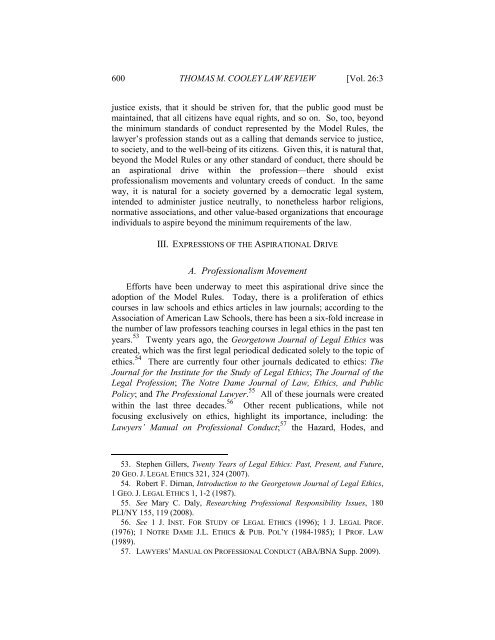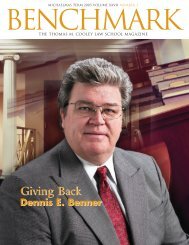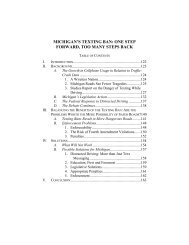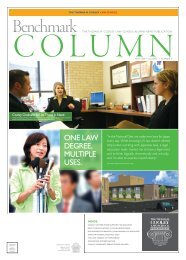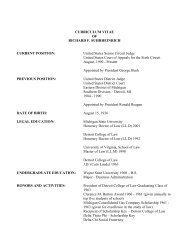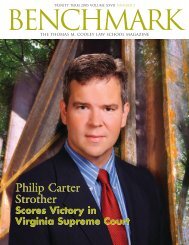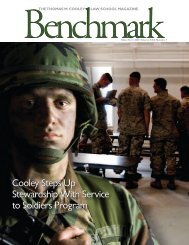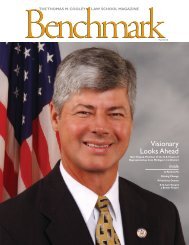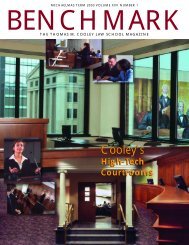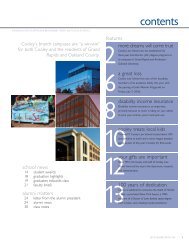Beyond The Model Rules - Thomas M. Cooley Law School
Beyond The Model Rules - Thomas M. Cooley Law School
Beyond The Model Rules - Thomas M. Cooley Law School
Create successful ePaper yourself
Turn your PDF publications into a flip-book with our unique Google optimized e-Paper software.
600 THOMAS M. COOLEY LAW REVIEW [Vol. 26:3justice exists, that it should be striven for, that the public good must bemaintained, that all citizens have equal rights, and so on. So, too, beyondthe minimum standards of conduct represented by the <strong>Model</strong> <strong>Rules</strong>, thelawyer’s profession stands out as a calling that demands service to justice,to society, and to the well-being of its citizens. Given this, it is natural that,beyond the <strong>Model</strong> <strong>Rules</strong> or any other standard of conduct, there should bean aspirational drive within the profession—there should existprofessionalism movements and voluntary creeds of conduct. In the sameway, it is natural for a society governed by a democratic legal system,intended to administer justice neutrally, to nonetheless harbor religions,normative associations, and other value-based organizations that encourageindividuals to aspire beyond the minimum requirements of the law.III. EXPRESSIONS OF THE ASPIRATIONAL DRIVEA. Professionalism MovementEfforts have been underway to meet this aspirational drive since theadoption of the <strong>Model</strong> <strong>Rules</strong>. Today, there is a proliferation of ethicscourses in law schools and ethics articles in law journals; according to theAssociation of American <strong>Law</strong> <strong>School</strong>s, there has been a six-fold increase inthe number of law professors teaching courses in legal ethics in the past tenyears. 53 Twenty years ago, the Georgetown Journal of Legal Ethics wascreated, which was the first legal periodical dedicated solely to the topic ofethics. 54 <strong>The</strong>re are currently four other journals dedicated to ethics: <strong>The</strong>Journal for the Institute for the Study of Legal Ethics; <strong>The</strong> Journal of theLegal Profession; <strong>The</strong> Notre Dame Journal of <strong>Law</strong>, Ethics, and PublicPolicy; and <strong>The</strong> Professional <strong>Law</strong>yer. 55 All of these journals were createdwithin the last three decades. 56 Other recent publications, while notfocusing exclusively on ethics, highlight its importance, including: the<strong>Law</strong>yers’ Manual on Professional Conduct; 57 the Hazard, Hodes, and53. Stephen Gillers, Twenty Years of Legal Ethics: Past, Present, and Future,20 GEO. J. LEGAL ETHICS 321, 324 (2007).54. Robert F. Dirnan, Introduction to the Georgetown Journal of Legal Ethics,1 GEO. J. LEGAL ETHICS 1, 1-2 (1987).55. See Mary C. Daly, Researching Professional Responsibility Issues, 180PLI/NY 155, 119 (2008).56. See 1 J. INST. FOR STUDY OF LEGAL ETHICS (1996); 1 J. LEGAL PROF.(1976); 1 NOTRE DAME J.L. ETHICS & PUB. POL’Y (1984-1985); 1 PROF. LAW(1989).57. LAWYERS’ MANUAL ON PROFESSIONAL CONDUCT (ABA/BNA Supp. 2009).


